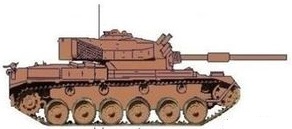History
The British Centurion tanks were the South African main battle tanks since 1957, but they were sold or relegated to reserve roles as a result of maintenance problems compounded by parts shortages and a tendency to overheat in the hot African climate. [2]
Thus, the Operation Savannah in 1975 saw the lightly armoured South African forces in Angola threatened by large formations of Soviet tanks supplied to the People's Armed Forces for the Liberation of Angola (FAPLA) and their Cuban allies. [3] Operation Savannah led to the need of further tank trials under Project Semel. South Africa purchased a number of surplus Centurion hulls from Jordan and India, [4] but the United Nations Security Council Resolution 418, which imposed a mandatory arms embargo on the country, forced South Africa to purchase them without turrets or armament. [2]
The South African government was obliged by the arms embargo to finance the creation of a new private sector enterprise, the Olifant Manufacturing Company (OMC), to refurbish the Centurions. The Semel program in 1974 counted a total of 35 conversions, soon used operationally. Informations from the Sho't program, the Israeli Centurion conversion program, helped greatly to start a more ambitious project. These refurbished tanks were named Olifant Mk.1. [3]
During Operation Askari South African forces clashed with FAPLA T-54/55 tanks in late 1983 and early 1984; however, due to the respective logistical commitment the Olifants were not deployed. [3] At length the South African mechanised infantry, bolstered by Eland and Ratel-90 armoured car squadrons, succeeded in destroying the Angolan tanks on their own. [5] But eventually, a single squadron of thirteen Olifant Mk.1As was sent to the Angolan border, where they were attached to the 61 Mechanised Battalion Group. Following the Lusaka Accords, which effectively ensured a ceasefire between South Africa and Angola, the Olifants Mk.1 were placed into storage and the tank crews rotated out. [5]
Starting in 1983, OMC had upgraded further Centurions with a 29-litre Teledyne Continental turbocharged diesel engine and a new transmission adopted from the M60 Patton. The refurbished Centurions were armed with a South African variant of the 105 mm L7 rifled main gun. They were accepted into service with the South African Armoured Corps as the Olifant Mk.1A in 1985. [4]
The launch of Operation Moduler, following the collapse of the Lusaka Accords in late 1987, led to the Olifant squadron being activated on the direct orders of President P.W. Botha. [3] On 9 November 1987 the Olifants destroyed two Angolan T-55s. [6] Throughout the operation, South African forces typically dispersed into an "arrowhead" formation, with Olifants in the lead, Ratel-90 armoured cars on the flanks, and the remainder of the mechanised infantry to the rear and centre. [7]
Three Olifants were abandoned in a minefield during Operation Packer from March to April 1988; one was retrieved by the Cubans and taken to the town of Cuito Cuanavale [8] : 338 and the other two remain to this day in the Angolan bush. [9] Another two were damaged beyond immediate repair by mines but successfully recovered. [10] A number of others suffered varying degrees of track and suspension damage due to mines or Angolan tank fire, but were able to keep moving after field repairs. [11] The operational failure by the SADF ended in a strategic stalemate.
Scholtz (2015) offers some of the most detailed observations about the use of Olifants in the war, including their tactics and operations, esp. during Operation Packer, which is the "stalemate at Tumpo". For Operation Packer, he relies on interviews with General Louw. Louw indicates that Lt. Gen. Kat Liebenberg, Chief of the Army, present at Fouche's HQ, countermanded an order to destroy the abandoned Oliphants, assuming they could be recovered later. They were not, as the SADF vacated the battlefield. As for the two tanks never recovered: "the other two proved impossible to move, so heavily had their tracks and suspensions been damaged." It was the only slightly damaged one that the Cubans recovered which eventually ended up in the USSR.
In the early 1990s, the Olifant Mk.1A was superseded by the Olifant Mk.1B, which incorporated major improvements in armour protection, a slightly more powerful engine, a double armoured floor for protection against mines, and a torsion bar suspension. It is barely recognisable as a Centurion. [12]
The Olifant Mk.2 was adapted in 2005 when South Africa was no longer subject to international embargoes. Externally, the Mk.2 looks identical to the Mk.1B but features an upgraded Continental 29 Litre turbo-charged V12 diesel engine that produces 1040 hp. Improvements include an upgraded Fire Control System (FCS) and a Computerised Battle System (CBS) which includes a hunter-killer mode. A LIW 120 mm smoothbore gun can be used instead of the 105 mm L7 rifled gun. In 2018, a total number of 26 Mk.2 tanks was produced. [13]




